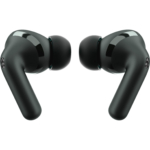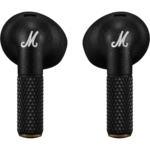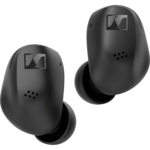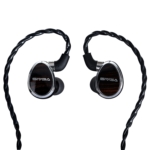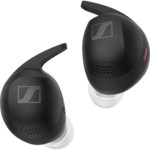With good manufacturing quality, shapely industrial design, innovative technical construction and convincing sound, the Burson Audio Funk makes its mark. The compact device delivers convincing sound performance to both loudspeakers and headphones. It can therefore be regarded as a contemporary music system that, although it has been reduced to the essentials in size and functionality, has been maximised in terms of sound. For the price of 649 Euros, you get a compact device that, with a suitable player, can replace a complete home stereo system. I can highly recommend this device to anyone who wants a compact, minimal, but sonically impressive device.
- Class-AB integrated amplifier
- Class-A headphone amplifier
- Interchangeable Burson Vivid opamps
- Innovative power supply
- Only one stereo RCA input
Good build quality, shapely industrial design and powerful outputs for headphones and speakers form the basis of this integrated desktop audio solution. Anyone looking for a future-proof home audio system should take a closer look at the Burson Audio Funk.
Burson Audio of Melbourne was founded over 20 years ago by a team of audio engineers and has since been manufacturing high-quality audio equipment and audio design components with a focus on headphone amplifiers and converters. A fundamental principle in their product development has been the manufacture of their own circuits and the choice of high-quality components.
Design, connections and operation
The Burson Audio Funk is a combination of headphone amplifier and hi-fi amplifier, making it a compact all-round solution for music enjoyment that definitely aims to meet more sophisticated requirements.
The Burson Audio Funk is delivered in a sturdy, well-padded package. In addition to the device, the package includes the external power supply unit, a replaceable Lf5a SMD fuse and an audio splitter adapter for connecting a gaming headset with a separate jack for headphones and microphone. An Allen key is used to open the housing to allow swapping of the operational amplifiers.
With its aluminium construction, this compact desktop unit goes for an appealing industrial aesthetic. Despite its relatively light weight, the device appears massive. Thanks to its four thick rubber feet, it stands non-slip on different surfaces and ensures stability when changing headphones.
The unit is encased in a strong 6mm aluminium housing, which also serves as a thermal sink for heat dissipation. It is made up of metal ribs all around and is screwed to the front and back of the case.
The front is typical of Burson and is made of a solid piece of brushed aluminium. Here, reduced to the most essential, you will find headphone connections for 6.35mm and 3.5mm (TRRS). The latter is used for headset headphones with microphones, e.g. for gaming. The matching output for looping through the microphone signal is located on the back.
The massive centrally placed non-switchable volume control comes from Alps (820G). Next to it is a switchable two-stage pre-amplification, the switch between headphone and speaker mode and the power switch. All switchable operations have visual indicators in the form of blue LEDs.
On the rear panel, there is only a single stereo cinch connector, a 3.5mm microphone input and gold-plated speaker connections that can be fitted with either banana plugs or stranded wires. Last but not least, the connection for the external power supply can be found here. A “Cool-Stand” can optionally be purchased from the manufacturer, and this enables positioning rotated by 90°.
Technology
Two independent amplifier units work inside the purely analogue Burson Audio Funk, and they are connected via two separate signal paths. Speakers are driven by a 45/35 watt (4/8 ohm) Class AB unit, and there is the option of swapping out the op-amps, similar to larger models. A NE5532 is used as per factory settings. Alternative compatible components can be used to customise this if required.
This discrete Class A headphone amplifier delivers 3 watts per channel at 16 ohms. This means that even low-power headphones can be effortlessly driven. The two-stage switchable amplification stage acts independently of the speaker output and offers detailed power adjustments to each set of headphones. There is also the option of further tuning the sound using different operational amplifiers, as is also the case with the Burson Audio Soloist 3X Grand Tourer. According to the manufacturer, this high performance is due to the special power supply. This is their own development which they call “Max Current Power Supply” (MCPS); it uses transistors instead of rectifiers and a coupling capacitor bank for conversion into direct current and is supposed to provide the necessary current particularly quickly. At the same time, the operating power of the supply frequency (50-60 Hz) is shifted to an inaudible operating range of 170 kHz.
Sound
A wireless MTX monitor with an integrated headphone amplifier served as our playback and comparison device. Other playback devices used were a Cambridge Audio CXN V2, a CD player (NAD 512), a smartphone (Samsung Galaxy S7) and an iBasso DX 240 DAP. For headphones we used models from Stax, Hifiman Edition XS, Focal Spirit Professional, Sony MDR-V600 (45 ohms), iBasso SR2 and the Sennheiser HD 25 II. The integrated amplifier test was done with a pair of Cerwin Vega DC 15s at 4 ohms.
Mighty speakers require sufficient power and control to drive the 15″ bass. We were surprised to find that the little Funk had no problems with this task. It has enough power to push well beyond room volume. Basses were reproduced voluminously but in a controlled manner, the midrange was differentiated and finely resolved, and the treble was clear and airy. In addition, we were pleased with the subtly resolved low-frequency range and nuanced dynamics. The Funk sailed through all these tasks with flying colours and can easily be described as having a high-end attitude – and it made listening to music with loudspeakers a lot of fun.
However, our main focus was on the headphone amplifier. As a magnetostat, the Hifiman Edition XS requires a powerful partner in order to perform with full power and speed, which this device readily provides with air to spare at the top. Even in the 10 o’clock position, it sounds full-bodied with a rich volume. The basses of a Moog synthesizer were reproduced stably down to the lowest range. Despite the enormous depth, the tonal part could still be heard. However, this lowest frequency range was less defined. In the octave above, around 80 Hz, the tonality was more precise.
The lower to upper mid-range was reproduced in a differentiated way with a slightly warm colouration. Even tonally dense material sounded transparent with distinct contours from the individual instruments. And thanks to the extended frequency response, the high-frequency range always sounded open and light. Reverberation tails were clearly delineated and the depth staggering offered decent detail. Both the dynamic gradations and the size of the virtual sound stage felt convincing and satisfying. Since the Funk is not dedicated to any musical focus, any style of music sounds neutral with a slightly warm colouration. In combination with the universal iBasso DX240 DAP, there was nothing left to be desired.
Technical specifications
- Ear couplingAmplifier
- TypeDesktop
- Frequency response (headphones)± 1 dB: 0 – 35.000 Hz
- Impedanceab 16 ohms
- Sound pressure level (SPL)@1 kHz: 128 dB
- Weight without cableapprox. 3,000 g
What's in the box
- Audio splitter adapter
- Allen key
- Power supply unit















